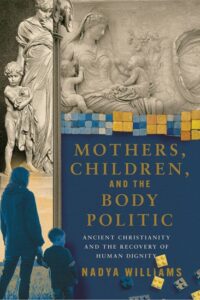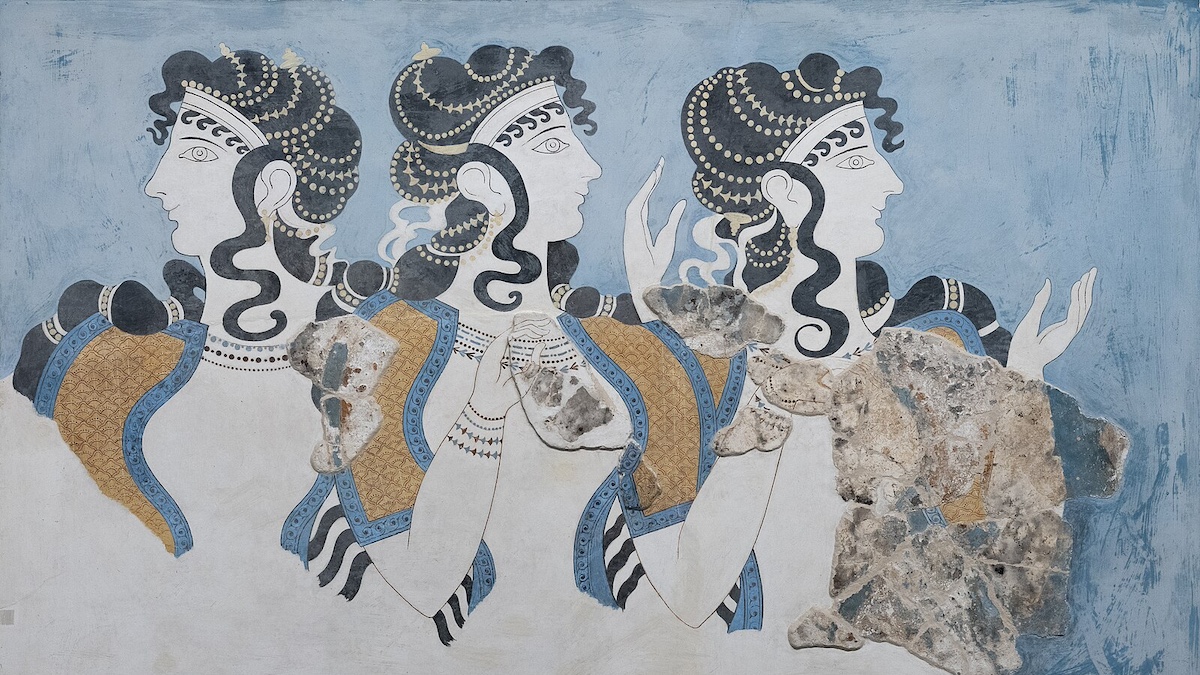A decade ago, I taught an upper-level college class on women in the ancient world. I was surprised to discover on the first day that an entire sorority had signed up, excited to learn about the Amazons and Cleopatra. Spoiler alert: there were many more women in the ancient world than just the Amazons and Cleopatra. Who knew? Not the average denizen of modernity, for sure.
My students’ starting perspective may seem woefully inadequate, but it is typical. How many women from antiquity can most people today name? Probably many fewer than men, and that’s a shame. The women were there, and they were up to something significant, whether or not they realized it at the time. They simply went about their ordinary tasks: weaving, cleaning, cooking, raising kids, and occasionally killing an enemy general by throwing a rooftile down on his head.
Classicist Daisy Dunn has written The Missing Thread: A Women’s History of the Ancient World with two goals in mind: first, to introduce the public to many more women from antiquity; and second, to show that the actions of women, both named and unnamed, truly mattered—historically speaking.
Dunn decidedly does not want this history to be a mere catalog of famous people, writing:
The importance of ancient women’s work exceeds the contributions of extraordinary individuals. Together women helped to make antiquity as we know it. They were creators of history. It feels only right to think of them in this collective sense given how many died without being able to leave their own mark upon the world.
Still, this isn’t just a book “about women” in the ancient world. It is, rather, a comprehensive history of the ancient world from the Bronze Age to the death of Nero. Dunn “aims to bring women to the fore without distorting the reality of events by pretending that men were not usually in charge.” Instead, she counsels, we ought to push such great men “to the borders slightly, and light may fall upon the clearing to reveal the women in their shadow.”
Dunn’s approach offers a tantalizing alternative to the more standard approach to history, even as her decision to conclude the book with the death of Nero circumvents another story that could be its own book: a women’s history of Late Antiquity, including the story of women in early Christianity. It is that story, beginning with a teenage mother from a backwater town in the Roman province of Judaea, that challenged the Greco-Roman paradigm, showing that the weak, the meek, and the mothers could also make history.
While Christianity is not part of Dunn’s book or methodology, her history reflects a distinctly Christian—rather than pagan—understanding of history as a story in which every person, no matter how weak or lowly and powerless in worldly terms, is significant not because of anything famous she has accomplished, but simply because she lived. It is this Christian vision of history that offers a place for appreciating not just the grand arc of political history, but the private hum and bustle—and sometimes great suffering too—of the domestic life.
Women in Bronze Age Civilization
Who makes history? Not well-behaved women, the adage goes. But who decides who is interesting enough to “make history,” and what they must do to be worthy of this designation? The truth is, the writing of history is a much less objective science than modern academics would like to pretend. We all tend to see what we want to see—or, too often, what we expect to see. When it comes to the grand narratives of ancient classical history, we expect Achilles, Alexander, Caesar, and various other famous military and political leaders to show up—all of them men.
We often forget, when looking at these famous men too intently, that day by day, they were surrounded by other, quieter figures who performed various tasks of care, support, and advising that made it possible for them to become who we know them to be. Women shaped these famous men—their decisions, personalities, whims—and in the process, those women shaped history.
More women than we can imagine also shaped history in their own right. Our assumptions to the contrary are due, in part, to the infelicities of source survival. “We know the names of many female artists and writers, but possess the works of few,” Dunn observes. Reading the catalog of losses that Dunn intersperses throughout the book, I was reminded why classicists’ favorite conversation topic is debating which ancient author’s works you wish had survived but didn’t. I’ll add this one to my list: “Pamphila, a seminal first-century AD female historian from Epidaurus in Greece (her thirty-three book work of Historical Commentaries is sadly lost but was quoted from by male writers in antiquity).”
Although we rightfully mourn these losses, Dunn’s book proves that there is still an abundance of evidence to help us learn about women’s lives in the ancient world—so long as we are willing to look beyond what we are used to seeing.
Dunn begins her historical survey with Minoan Crete, the magnificent Bronze Civilization in whose art women play prominent roles: weaving, dancing, performing religious rites, holding bulls by the horns for ceremonial bull leaping, and doing commerce with another civilization of strong women, the Egyptians. Intricate webs of diplomacy—often brokered through women’s letter-writing—connected the Egyptians also to the Hittites, another powerful Bronze Age empire. The priestess-queen Puduhepa ruled the Hittite Empire with her husband in the mid-thirteenth century BC. She boldly wrote to Pharaoh Rameses for assistance at a time of famine, “signing her letter with her own seal.” Rameses was happy to oblige, and his wife, queen Nefertari, wrote Puduhepa and sent her gifts as well.
And then there is “the earliest named author in the world”—the Sumerian poet and daughter of the powerful king Sargon of Akkad, Enheduanna. Her poetry was celebrated and preserved under her own name, offering evidence of “Mesopotamians’ tolerance of female displays of power.” This is, by the way, in sharp contrast to modern literary scholars, who for centuries largely ignored Enheduanna. Enheduanna’s counterpart in the Greek world—not as the earliest poet but as one of the most distinguished—is the love poet Sappho from Lesbos. As Dunn notes, Sappho was also involved in the political machinations of the day, earning exile for her efforts at one point. Even without formal political roles, it seems that women could wield sufficient influence to be exiled for it.
Tales of the (Female) Greeks and Romans
Once we reach the fifth century BC, there is more evidence for us to work with, and the stories of not only famous women but also nameless ones grow richer. Here, as elsewhere in the book, Dunn draws on both textual sources—all the rich stories that ancient historians and other authors have left us—and archaeological evidence to tell the story of women’s presence. Just as we might track the presence of warring men by arrowheads and other remains of weaponry, loom weights and whorls invariably amount to a sort of quiet declaration, reaching to us across millennia: women were here too.
Dunn tells the story of the Pythia, priestesses of Apollo at Delphi, whose decisions shaped Greek history in dramatic ways. We also meet Artemisia, the cunning Greek queen who joined the side of the Persian King Xerxes during the second Persian invasion of Greece. In a world of male warlords and generals, seeing women leading military forces is a surprise that challenges our assumptions about the ancient world.
The fifth century BC brings the Romans into the story, as their documented history begins in earnest. Looking back into the misty legends of early Rome, the age of the seven kings, Dunn notes the prevalence of women in shaping policy behind the scenes, and the power of domestic politics and events in dictating events in the Roman state. Early Roman history is punctuated by tales of violence against women—most famously, the kidnapping and rape of the Sabine women and the rape and suicide of Lucretia.
Once the Romans start expanding beyond their tiny village on the Tiber, they were at war more years than not. But even in those tales of conquest, the women are right there, if we just look—as in the stories of sacrifices of jewelry and other valuable property that Roman women were repeatedly asked to make to help the state. It was the women who, at times, appeared to be financing the Roman war effort. Earrings can go far in a time of crisis, it turns out.
Marriage alliances and the infinitely difficult politics those unleashed in the Roman Republic and the early Empire receive significant attention. Women had little say about who they married, and were often forced by male relatives to divorce in order to marry someone else, creating a more advantageous alliance. Yet, seeing fathers or brothers fight husbands or ex-husbands, Roman aristocratic women felt incredible pressures to create peace where none was to be found, and bear children to cement alliances. As Dunn notes, “We should never forget that the most cataclysmic episodes in Rome’s history often affected women the most severely.”
Dunn concludes her story in AD 68 with the suicide of the Emperor Nero, the last of the Julio-Claudian dynasty. In his death, we find the emperor surrounded by women, as two of his childhood nurses and his mistress lovingly bury him after he has been abandoned by all others.
Can Women’s Daily Labor Really Can the World?
The book is riveting. Dunn is an excellent storyteller and a master of the primary sources. Still, the question remains: what is the point of this exercise? Surely this narrative, even when we bring women into it more prominently, shows exactly what we have known all along: that in the ancient world, it was mostly men who called the shots. Indeed, that is the complaint articulated by another reviewer, Sarah Ruden. Can we really conclude after all this that women shaped ancient history, Ruden wonders?
It is a worthwhile question, and one with direct applications for us today. I contend that Dunn’s approach offers a fruitful model not only for how we think about contributions of individuals and groups to ancient history, but also for how we think about own lives as women in the twenty-first century. We, too, ask ourselves: does our daily work matter?
If we’re honest, many of us care about our legacy; we dream of “making history.” But how do such grandiose dreams connect to the unglamorous reality of the activities that we spend much of our lives doing, whether we work outside the home or not—making meals, carrying babies within the womb and in our arms, caring for sick children and various other relatives, doing laundry and dishes? All of these activities weave the fabric of our daily lives no less intricately than the fabric so many women in this book literally wove as part of their own household duties.
What is the influence of our own lives in the grand scheme of history, if we are not generals, politicians, or presidents?
This is a question that has strong pre-Christian Roman pagan undertones. Before Christianity, it was, indeed, the default assumption that the most politically powerful made history. Too often, historians have continued to embrace this paradigm. But, as this book shows, there is another way.



